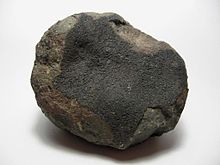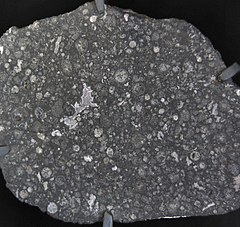Allende (meteorite)
| Allende | |
|---|---|

Allende fragment
|
|
| Type | Chondrite |
| Class | Carbonaceous chondrite |
| Group | CV3 |
| Composition | 23.85% total iron |
| Shock stage | S1 |
| Country | Mexico |
| Region | Pueblito de Allende, Allende, Chihuahua |
| Coordinates | 26°58′N 105°19′W / 26.967°N 105.317°WCoordinates: 26°58′N 105°19′W / 26.967°N 105.317°W |
| Observed fall | Yes |
| Fall date | 01:05 local time (07:05 GMT) on 1969 February 8 |
| TKW | 2 tonnes |
| Strewn field | Yes |
 Chondrules of Allende |
|
The Allende meteorite is the largest carbonaceous chondrite ever found on Earth. The fireball was witnessed at 01:05 on February 8, 1969, falling over the Mexican state of Chihuahua. After breaking up in the atmosphere, an extensive search for pieces was conducted and over 2 tonnes (tons) of meteorite were recovered. The availability of large quantities of samples of the scientifically-important chondrite class has enabled numerous investigations by a large number of scientists; it is often described as "the best-studied meteorite in history." The Allende meteorite has abundant, large calcium-aluminium-rich inclusions, which are among the oldest objects formed in the Solar System.
Carbonaceous chondrites comprise about 4 percent of all meteorites observed to fall from space. Prior to 1969, the carbonaceous chondrite class was known from a small number of uncommon meteorites such as Orgueil, which fell in France in 1864. Meteorites similar to Allende were known, but many were small and poorly studied.
The original stone is believed to have been approximately the size of an automobile traveling towards the Earth at more than 10 miles per second. The fall occurred in the early morning hours of February 8, 1969. At 01:05 a huge, brilliant fireball approached from the southwest and lit the sky and ground for hundreds of miles. It exploded and broke up to produce thousands of fusion crusted pieces. This is typical of falls of large stones through the atmosphere and is due to the sudden braking effect of air resistance. The fall took place in northern Mexico, near the village of Pueblito de Allende in the state of Chihuahua. Allende stones became one of the most widely distributed meteorites and provided a large amount of material to study, far more than all of the previously known carbonaceous chondrite falls combined.
Stones were scattered over a huge area – one of the largest meteorite strewnfields known. This strewnfield measures approximately 8 by 50 kilometers. The region is desert, mostly flat, with sparse to moderate low vegetation. Hundreds of meteorite fragments were collected shortly after the fall. Approximately 2 or 3 tonnes of specimens were collected over a period of more than 25 years. Some sources guess that an even larger amount was recovered (estimates as high as 5 tonnes can be found), but there is no way to make an accurate estimate. Even today, over 40 years later, specimens are still occasionally found. Fusion crusted individual Allende specimens ranged from 1 gram (0.035 oz) to 110 kilograms (240 lb).
...
Wikipedia
